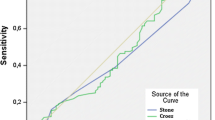Abstract
In this study, we aim to evaluate the accuracy of STONE (stone size, tract length, obstruction, number of involved calyces, and essence/stone density), Clinical Research Office of the Endourological Society (CROES), and Guy’s nephrolithometry scoring systems (NSS) in obese patients. The charts of patients who underwent percutaneous nephrolithotomy (PNL) between June 2008 and June 2016 were retrospectively analyzed. Calculations of the STONE, CROES, and Guy’s NSS were performed by a resident who was well informed regarding each NSS. Patients were classified under nine scores according to STONE, four grades according to CROES, and four grades according to Guy’s NSS. In total, 248 obese patients were enrolled in the study. Stone size was significantly higher in patients without stone-free status (p = 0.001). In patients who were stone-free and those with residual stones, the mean STONE score was 9.71 and 9.23 (p = 0.160), CROES was 172 and 129 (p = 0.001), and Guy’s NSS was 1.67 and 2.75 (p = 0.001). Multivariate regression analysis identified the CROES and Guy’s NSS were independent factors for PNL success in obese patients (p = 0.01 and p = 0.01, respectively). The CROES and Guy’s NSS showed good accuracy with PNL success (AUC = 0.777 and AUC = 0.844, respectively). None of the three NSS systems were statically associated with a complication rate (p = 0.23 for STONE, p = 0.14 for CROES, and p = 0.51 for Guy’s NSS). Our study demonstrated that CROES and Guy’s NSS were independent predictors of stone-free rate following PNL in obese patients. Our study also revealed that three of the NSSs were not useful for predicting PNL complications in obese patients.


Similar content being viewed by others
References
Türk C, Petrik A, Sarica K et al (2016) EAU guidelines on diagnosis and conservative management of urolithiasis. Eur Urol 69:468–474
Torrecilla Ortiz C, Meza Martínez AI, Vicens Morton AJ et al (2014) Obesity in percutaneous nephrolithotomy. Is body mass index really important? Urology 84:538–543
de Simone G, Devereux RB, Chinali M et al (2007) Prognostic impact of metabolic syndrome by different definitions in a population with high prevalence of obesity and diabetes: the strong heart study. Diabetes Care 30:1851–1856
Calvert RC, Burgess NA (2005) Urolithiasis and obesity: metabolic and technical considerations. Curr Opin Urol 15:113–117
Okhunov Z, Friedlander JI, George AK et al (2013) STONE nephrolithometry: novel surgical classification system for kidney calculi. Urology 81:1154–1159
Smith A, Averch TD, Shahrour K et al (2013) A nephrolithometric nomogram to predict treatment success of percutaneous nephrolithotomy. J Urol 190:149–156
Thomas K, Smith NC, Hegarty N, Glass JM (2011) The Guy’s stone score–grading the complexity of percutaneous nephrolithotomy procedures. Urology 78:277–281
Dindo D, Demartines N, Clavien PA (2004) Classification of surgical complications: a new proposal with evaluation in a cohort of 6336 patients and results of a survey. AnnSurg 240:205–213
Kuntz NJ, Neisius A, Astroza GM et al (2014) Does body mass index impact the outcomes of tubeless percutaneous nephrolithotomy? BJU Int 114:404–411
Fuller A, Razvi H, Denstedt JD et al (2012) The CROES percutaneous nephrolithotomy global study: the influence of body mass index on outcome. J Urol 188:138–144
Mandal S, Goel A, Kathpalia R et al (2012) Prospective evaluation of complications using the modified Clavien grading system, and of success rates of percutaneous nephrolithotomy using Guy’s Stone Score: a single-center experience. Indian J Urol 28:392–398
Ingimarsson JP, Dagrosa LM, Hyams ES, Pais VM Jr (2014) External validation of a preoperative renal stone grading system: reproducibility and inter-rater concordance of the Guy’s stone score using preoperative computed tomography and rigorous postoperative stone-free criteria. Urology 83:45–49
Akhavein A, Henriksen C, Syed J, Bird VG (2015) Prediction of single procedure success rate using S.T.O.N.E. nephrolithometry surgical classification system with strict criteria for surgical outcome. Urology 85:69–73
Sfoungaristos S, Gofrit ON, Yutkin V, Landau EH, Pode D, Duvdevani M (2016) External validation of CROES nephrolithometry as a preoperative predictive system for percutaneous nephrolithotomy outcomes. J Urol 195:372–376
Tailly TO, Okhunov Z, Nadeau BR et al (2016) Multicenter external validation and comparison of stone scoring systems in predicting outcomes after percutaneous nephrolithotomy. J Endourol 30:594–601
Labadie K, Okhunov Z, Akhavein A et al (2015) Evaluation and comparison of urolithiasis scoring systems used in percutaneous kidney stone surgery. J Urol 193:154–159
Sfoungaristos S, Gofrit ON, Pode D, Landau EH, Duvdevani M (2016) Percutaneous nephrolithotomy for staghorn stones: which nomogram can better predict postoperative outcomes? World J Urol 34:1163–1168
Choi SW, Bae WJ, Ha US et al (2017) Prediction of stone-free status and complication rates after tubeless percutaneous nephrolithotomy: a comparative and retrospective study using three stone-scoring systems and preoperative parameters. World J Urol 35:449–457
Kumar S, Sreenivas J, Karthikeyan VS, Mallya A, Keshavamurthy R (2016) Evaluation of CROES nephrolithometry nomogram as a preoperative predictive system for percutaneous nephrolithotomy outcomes. J Endourol 30:1079–1083
Yarimoglu S, Polat S, Bozkurt IH et al (2016) Comparision of S.T.O.N.E and CROES nephrolithometry scoring systems for predicting stone-free status and complication rates after percutaneous nephrolithotomy: a single center study with 262 cases. Urolithiasis. doi:10.1007/s00240-016-0935-0
Author information
Authors and Affiliations
Corresponding author
Ethics declarations
Conflict of interest
The authors declare that they have no conflict of interest.
Ethical standards
Informed consent was obtained preoperatively from all of our patients, who were included in our study.
Rights and permissions
About this article
Cite this article
Ozgor, F., Yanaral, F., Savun, M. et al. Comparison of STONE, CROES and Guy’s nephrolithometry scoring systems for predicting stone-free status and complication rates after percutaneous nephrolithotomy in obese patients. Urolithiasis 46, 471–477 (2018). https://doi.org/10.1007/s00240-017-1003-0
Received:
Accepted:
Published:
Issue Date:
DOI: https://doi.org/10.1007/s00240-017-1003-0




